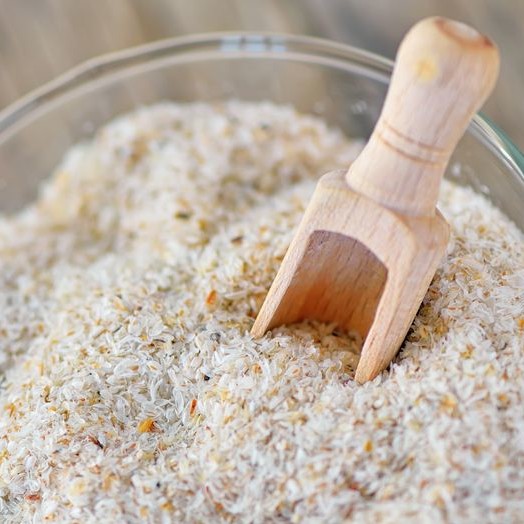Soluble Fiber
Also known as soluble dietary fiber
What is Soluble Fiber?
Soluble fiber is a material derived from plant sources that can be added in baking applications to enhance a final product’s properties.
These types of ingredients can act as thickening agents and also lend volume to baked goods, particularly those without gluten. The material is non-digestible by humans.
Origin
Soluble fiber is typically found in plant-derived ingredients. Plants contain both soluble and insoluble fibers. As such, there are any number of fruits, vegetables, seeds, and grains containing soluble fiber, some of which may be genetically modified.
Fibers are most popularly classified by how they react in water. While soluble fiber dissolves in water and forms a gel, insoluble fiber does not. Some of these fiber-containing plants are routinely consumed by humans; others that are the basis for soluble fibers used in baking and food production, such as chicory root and Jerusalem artichoke are not commonly a part of the standard diet in the United States. Chicory root and Jerusalem artichoke contain inulin, a generally recognized as safe ingredient used as a bulking agent.1
Function
Soluble fiber can be added to fine baked goods to improve the texture of non-traditional baked goods—namely, gluten-free items. This is accomplished by adding both a long flexible, insoluble fiber and a low viscosity soluble fiber, for example. This helps provide structure to a bread during the leavening process.
Other baked goods benefit from the addition of both an insoluble fiber with great water absorption properties and a soluble fiber that has a high viscosity. This helps improve the baked item’s mouthfeel. In some applications the addition of resistant starches and/or gums may be warranted.2
Nutrition
A diet with adequate amounts of both soluble and insoluble fiber leads to many health benefits. High fiber diets have been associated with decreased risk of colon cancer and breast cancer.
Commercial production
A naturally-available ingredient, soluble fiber is typically found in a wide variety of plants. Each of these have slightly different properties that contribute to the desired end product. These include:
- Beta-glucan, found in grains such as oats, rye, and barley
- Pectin or sugar acids, found in fruits, vegetables legumes, and sugar beets
- Various gums; inulin, found in foods such as chicory, onions, wheat, and Jerusalem artichokes3
Most often these are derived by extracting or separating the material from a plant or from a seed’s bran.4
Application
Soluble fiber ingredients can be added to baked goods to improve volume and rise, while also reducing a product’s calorie count. This can be used to create potentially healthier products with similar taste and mouthfeel to conventional products.
Some soluble fibers, such as gums, are used for specific properties they provide to the end product. Gums can be used to thicken, for example, and to increase moisture retention in a baked good. Because the amounts of these ingredients used is typically small, other ingredients such as oat or wheat bran may be added, in amounts of between 10 to 30 percent on a flour basis, to increase the fiber content.4
Some soluble fibers used as baking ingredients:
| Soluble Fiber | Source | Function |
| Arabinoxylans | Grass bran | Altering water binding, dough rheology, gas retention |
| Beta-glucan | Cereal grains | Thickening, emulsifying, coating |
| Carrageenan | Red seaweed | Thickening, suspension, gelling, casein stabilizing |
| Guar gum or guaran | Guar bean | Thickening, stabilizing, emulsifying |
| Inulin | Fruits, vegetables, herbs, wheat | Product improvement, sweetening |
| Pectin | Includes apple, citrus peel | Gelling, thickening, binding water, stabilizing, replacing fat and/or sugar |
| Psyllium husk | Plantago ovata seeds | Providing structure to gluten-free doughs |
FDA regulation
“Food manufacturers may voluntarily list the amount in grams (g) per serving of soluble fiber and insoluble fiber on the Nutrition Facts Label (under Dietary Fiber),” the United States Food and Drug Administration said, “but they are required to list soluble fiber and/or insoluble fiber if a statement is made on the package labeling about their health effects or the amount (for example, ‘high’ or ‘low’) contained in the food.”5
The specific, permissible health claims are contained in Title 21, Volume 2, of the Code of Federal Regulations.6
References
- United States Food and Drug Administration, Office of Nutrition and Food Labeling, Center for Food Safety and Applied Nutrition. Science Review of Isolated and Synthetic Non-Digestible Carbohydrates, U.S. Department of Health and Human Services, Nov. 2016. www.fda.gov/downloads/Food/LabelingNutrition/UCM529049.pdf. pp. 30, 66. Last accessed 3 December 2018.
- Dar, Y., and J. Light. Food Texture Design and Optimization. Wiley-Blackwell, 2014. p. 259.
- “A Soluble Fiber Primer – Plus the Top Five Foods That Can Lower LDL Cholesterol.” Today’s Dietitian, www.todaysdietitian.com/newarchives/120913p16.shtml. Last accessed 3 December 2018.
- Hartikainen, K., and K. Katina. “Improving the Quality of High-Fibre Breads.” Breadmaking, 2012, pp. 736–753., doi:10.1533/9780857095695.4.736.
- “Interactive Nutrition Facts Label Factsheets: Dietary Fiber.” United States Food and Drug Administration Website, United States Food and Drug Administration, www.accessdata.fda.gov/scripts/InteractiveNutritionFactsLabel/factsheets/Dietary_Fiber.pdf. Last accessed 17 December 2018.
- “CFR – Code of Federal Regulations Title 21.” Accessdata.fda.gov, www.accessdata.fda.gov/scripts/cdrh/cfdocs/cfcfr/CFRSearch.cfm?fr=101.81. Last accessed 17 December 2018.


